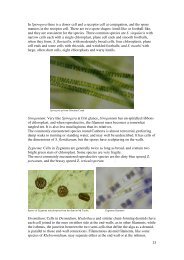Filamentous Freshwater Algae of the ACT, a preliminary list
Filamentous Freshwater Algae of the ACT, a preliminary list
Filamentous Freshwater Algae of the ACT, a preliminary list
You also want an ePaper? Increase the reach of your titles
YUMPU automatically turns print PDFs into web optimized ePapers that Google loves.
eing replaced by what may be a succession <strong>of</strong> green algae from spring, through<br />
summer and into early autumn.<br />
There may be a correlation between <strong>the</strong> Hydrodictyon bloom and <strong>the</strong> jump in<br />
electrical conductivity, but this remains to be demonstrated. New Zealand studies<br />
suggest that Hydrodictyon can exploit ra<strong>the</strong>r low N and P but that it thrives on<br />
inorganic Nitrogen (Wells et al. 1999; Hall & Payne 1997).<br />
The retention <strong>of</strong> Oedogonium capillare and Spirogyra singularis in times <strong>of</strong> fast flow<br />
may possibly have a little to do with basal attachment in Oedogonium and occasional<br />
rhizoid formation in Spirogyra.<br />
It would be foolhardy to make any fur<strong>the</strong>r observations from <strong>the</strong>se few data. There is<br />
a need to ga<strong>the</strong>r similar data correlations at several o<strong>the</strong>r sites in <strong>the</strong> Upper<br />
Murrumbidgee Catchment, and continuing data collection at this site. What Table 1<br />
does indicate is that correlations can be established if <strong>the</strong> information is forthcoming.<br />
Water Net (Hydrodictyon reticulatum) bloom in Tuggeranong Creek.<br />
6



